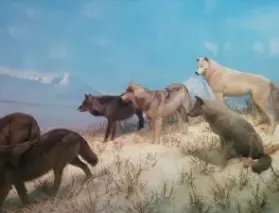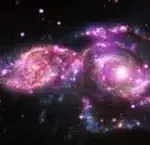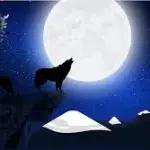
As my wife and I slogged along on our bicycles, generally irritated at each other, suddenly there was a pop. Her back tire went flat, and we were in the middle of nowhere on a Korean highway. We had to find a repair shop, communicate our problem, and somehow make it home.
As we pulled through this minor crisis, a peculiar thing happened: we were no longer irritated at each other. Through working together as a couple, each of us had moved from me to we. In some small way, we’d experienced a tiny moment of transcendence.
The urge to transcendence
“Birds gotta fly, fish gotta swim, and humans gotta be part of something greater than themselves.”
These are the words of social scientist Jonathan Haidt in a recent Point of Inquiry podcast. He expands on this insight in a video interview:
“Happiness comes from between. Happiness comes from being merged in, bound in, connected in the right ways to other people, to your work, and to something larger than yourself.”
In both of these quotes, Haidt links human nature to transcendence, feeling part of something greater or larger than yourself. The first suggests a brute need for it, the second that happiness itself is the result.
This squares with evolution. Multilevel selection theory observes that humans have a remarkable capacity to organize into groups, and well-organized groups out-compete others, leading to enhanced reproductive fitness for members. Thus, it does not seem a stretch to speculate that our evolved capacity to form into groups may derive from a general urge to be part of something greater than ourselves.
Naturalistic transcendence
When I speak of naturalistic transcendence*, I mean an experience of something greater than you not only in degree but also in kind, yet in which you nevertheless participate. In experiencing your participation in this something greater, you encounter something which challenges and transforms your whole sense of who and what you are, your way of being-in-the-world.
For example, stand at the foot of a mountain and you may be impressed by how much greater it is than you in degree, how alien it is from you in kind. Climb that mountain and confront limits of endurance beyond which you thought yourself incapable, feel the relation between yourself and the mountain’s flora and fauna as part of one interdependent ecosystem, and discover how the experience of the mountain becomes part of you and changes who you are – then you may draw close to something like transcendence.
Symbols of transcendence
One of our recent Thing on Thursday polls asked what symbols of transcendence most appeal to our readers. From these, I’d like to distill a set of symbols that may stand at the heart of a naturalistic path and embody its vision of transcendence.
Your personal symbol set may vary, but I’m going to pick out a triad that groups the most popular and vital together. The three are:
- nature
- community
- mind
The triad lends itself well to any kind of triple representation, like the triple spiral for example, but I prefer a series of concentric circles, like this:

Near the middle is a dot, representing the individual vantage point which makes up our conscious experience. It is off-center to underscore that you are not the center of the universe.
The individual ego is transcended by the whole mind, conscious and unconscious (inner circle), each mind is transcended by its communities (middle circle), and all communities are transcended by nature (outer circle).
Concentric circles are also the pattern of ripples, which one can imagine radiating from any point in the mandala to interact with the other circles.
The three bear some similarity to John Halstead’s “kindreds” (the physical world, ancestors, and the deep self), ADF’s Three Kindreds (Nature Spirits, Ancestors, and Gods and Goddesses), and the first two of three of Brendan Myers’ Immensities (the Earth, other people, death, and solitude).
Since these are intended as symbols and not analytical constructs, they may be interpreted broadly. Various alternative or elaborative terms may stand in, if they speak to you (e.g. cosmos for nature, ancestors for community, psyche for mind, etc.).
Also in keeping with symbols, these invite one’s own experiences to be reflected in them. Insofar all are included in nature, and nature includes all that is, every experience and every thing can be found somewhere within this triad. It thus forms a mandala for all experience.
The Three Transcendents share a few characteristics:
- they are greater than us in both degree and kind
- we participate in them even as they transcend us
- when they manifest as challenges, they do so not as problems that can be solved but as predicaments that can only be confronted and integrated
- there is no avoiding or escaping them for any human being; they are part of the human condition
- they demand to be handled with care, so as to affirm rather than negate the individual
- they are “Immensities” in Brendan Myers‘ sense, a term he borrowed from Yeats:
When we have drunk the cold cup of the moon’s intoxication, we thirst for something beyond ourselves, and the mind flows outward to a natural immensity
In parts 2-4 of this series, I’ll explore each of these symbols in depth. For now, I’ll conclude with a final justification for why such symbols are needed at all.
Why symbols of transcendence?
“Ritual is the engine of shamanic ecstasy and symbol is the pilot.” (Laughlin, McManus, & D’Aquili, Brain, Symbol, and Experience)
In my experience, what’s missing from Humanist, Atheist, Agnostic, and other such movements is a consciously-recognized, explicitly-articulated valuation of transcendence. John Halstead has made a similar observation of Unitarian Universalism, identifying the missing element as the enthusiasmos of transformative experience. The imagination must be captivated and transformed by a vision, not of what one is not, but of what one is or could be.
This missing element may be embodied in symbols that remind, invite, and inspire. The individual must be able to interact imaginatively with the symbols in ritual or meditation, and fill them up as it were with experience and affect. At that point, when they are charged with personal meaning and emotion, they may become powerful motivators of thought and behavior.
They radiate the power to transform.
UPDATE: John Halstead has posted a response to and extension of these ideas, which is well worth reading.
Continue to Part 2
Subscribe to The Spiritual Naturalist Society
Learn about Membership in the Spiritual Naturalist Society
__________
The Spiritual Naturalist Society works to spread awareness of spiritual naturalism as a way of life, develop its thought and practice, and help bring together like-minded practitioners in fellowship.
__________
*I have not always been entirely friendly to the language of transcendence. In fact, I have argued for non-transcendence as a key value. What I meant, though, was non-transcendence of the physical universe, of this earth, this body, or this life. Nowadays, I recognize that naturalism better sums up what I meant then.
__________
Written by B.T. Newberg. This article first appeared at HumanisticPaganism.com.













